Onam – God’s Own Celebration
- August 28, 2020

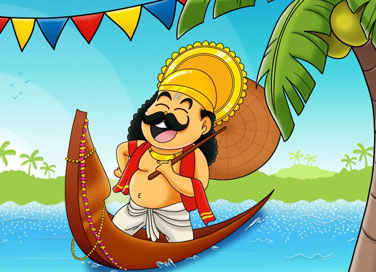
Onam – God’s Own Celebration
- August 28, 2020
By Samyukhtha Sunil
Onam is a harvest festival celebrated majorly in the state of Kerala and by Malayalees around the world. It is the time when the serene and calm façade of ‘god’s own country’ turns into a vibrant riot of colours and music. According to the Malayalam calendar, the festival falls in the month of Chingam which usually corresponds to the month of August or September. Deeply rooted in ancient Keralite culture, the festival is celebrated with much gusto and fervour. The festival in its entirety lasts for around 10 days and its concluding tenth day is viewed as Thiruvonam when most of the events and festival traditions are observed amongst Malayali households across the globe.
The legend behind Onam
To receive more such stories in your Inbox & WhatsApp, Please share your Email and Mobile number.
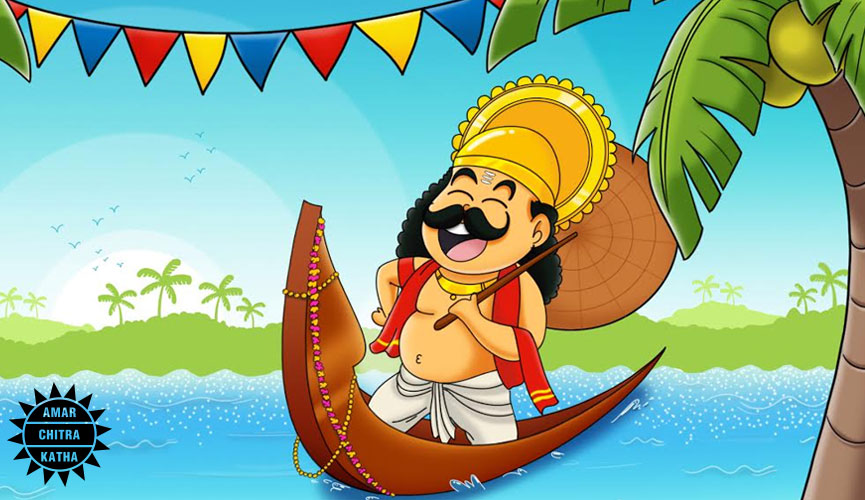
There is an interesting tale associated with this vibrant festival of the south. It commemorates the home-coming of King Mahabali all the way from pataal lok. King Mahabali was the grandson of Prahlada, the great devotee of Vishnu. With his penance and power, he had defeated everyone including the devas. He was the ruler of the three worlds. Aditi, the mother of the devas, prayed to Vishnu seeking help for her sons. Vishnu promised to help her at the right time.
One day, as Mahabali was performing a yagna, Lord Vishnu visited him disguised as a poor Brahmin dwarf, Vamana. The generous and just Mahabali greeted him with respect and was willing to give all that the Brahmin wished for. Vamana said, “I only seek three paces of land measured by my stride.” Surprised by this request, Mahabali happily agreed to grant him the land that he requested for. However, Mahabali’s chief advisor Shukracharya sensed that Vamana was no ordinary man and asked the king to rethink his decision. Since Mahabali had already given his word, he refused to retract it. It was at this moment that the unimaginable happened. Vamana started to expand massively in cosmic proportions much to the disbelief of everyone present in the palace. With his first step, he covered the entire land on Earth and with the second step he covered the land in the heavenly skies. He then asked Mahabali for space to place his third footstep.
Realizing that Vamana, indeed, was no ordinary Brahmin, Mahabali folded his hands in respect and bowed in front of Vamana. He asked Vamana to place the third step on his head, despite knowing that this would push him to pataal or the underworld. Pleased by this gesture, Lord Vishnu revealed himself and offered a boon to Mahabali. The king, who was so deeply attached to his kingdom and his people, requested Lord Vishnu to allow him to visit his kingdom once a year.
Each of the ten days of celebration marks the progress of Mahabali’s journey back home, and has their own individual significance. However, it is the first and the last day that are especially important. Throughout the festival, the people of Kerala gear up with interesting preparations to welcome their beloved king. To make sure Mahabali doesn’t feel that his sacrifice went in vain, Malayalees dress in their finest, have elaborate feasts, decorate the house with magnificent floral displays and so on.
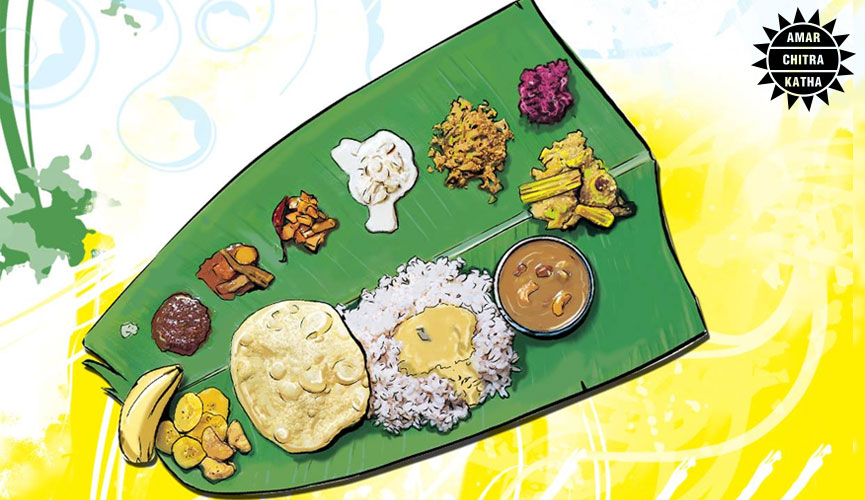
No Onam celebration is complete without the Onam sadhya. It is an extravagant meal which consists of nearly 30 mouth-watering vegetarian dishes prepared by the members of the family, and is served on a traditional banana leaf. In the centre, you will see a mountain of rice accompanied by parippu or lentils with a spoonful of ghee, sambar, and rasam. Surrounding it will be avial or mixed vegetables cooked with coconut, various thorans or dry vegetable dishes, kaalans that are sour vegetable curries, spicy sweet erisheris usually made from pumpkins or bananas and tangy pullisheris traditionally made from mangoes. There will also be an assortment of pickles made from mangoes, lemons and even ginger! The meal starts with a few pieces of banana chips and jaggery, and is rounded off with different types of deliciously sweet payasam made from jaggery or rice flakes. It is customary to have a little rice with curd or buttermilk after the payasam to help with digestion.
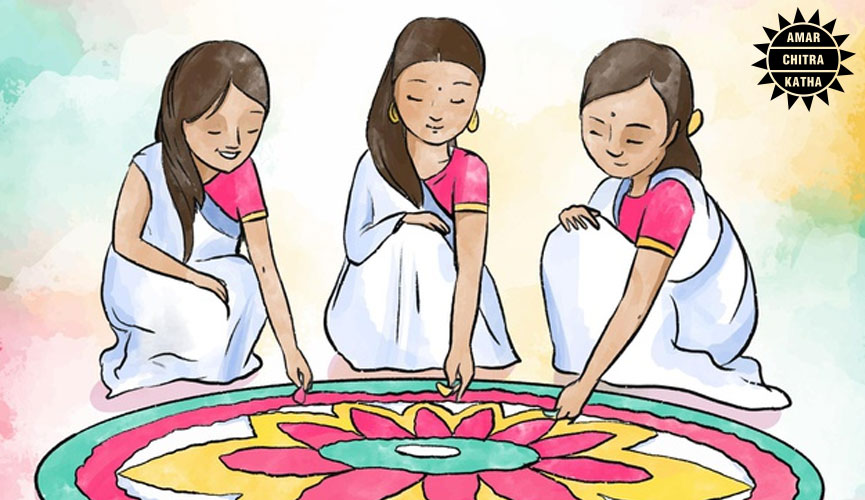
One of the most iconic parts of the Onam celebration has to be the Pookalam or the flower arrangement. Members of the community or a family gather in large numbers to create a massive flower arrangement on the floor of their homes or in common public spaces to highlight the festive spirit. Modern-day pookalams are highly evolved in their designs and aesthetic, with numerous competitions held across the state on the day.
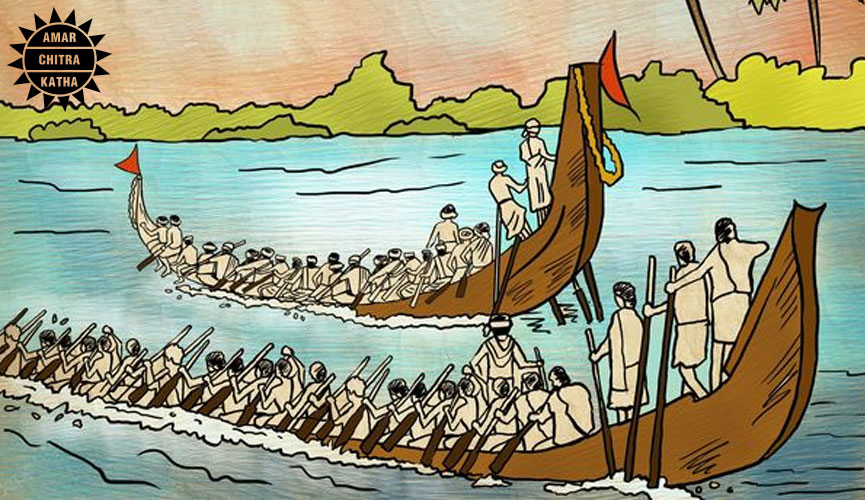
A layman’s idea of Kerala will definitely bring to mind the long snake boats that have become iconic of the state. Vallam Kali translates to boat race, and is one of the highlights of this time of the year in Kerala. The Nehru Trophy boat race is perhaps the most prestigious in the sport and takes place in the backwaters of Alleppey during the second weekend of August, with people from across the globe converging to witness the event. Longboats over a hundred feet long manned by teams of 100+ race against each other to cover a 2-kilometre race track on the backwaters to win the coveted trophy. To watch these massive teams row at hyperspeed in perfect synchronization is a sight to behold!
Much like any other Indian festival, there is a lot of singing and dancing associated with Onam celebrations as well. At home, women clad in white and gold sarees perform a special dance called the Thiruvathira kali, that involves dancing in a circle while clapping each other’s hands. Outside, there are massive parades where the more rotund men paint their bodies as tigers and perform the famous puli kali, or tiger dance, to the beats of the chenda, a traditional drum found in Kerala. There are also a lot of games played during the festival, the most prominent one being the vadamvali or tug of war!
To receive more such stories in your Inbox & WhatsApp, Please share your Email and Mobile number.

Comic of The Month
The Naval Journey of India Book I
This book is the first of a three-book series that takes a deep and detailed look at India's Naval History and a deep insight into the lives of our men and women in white. But any series on the Indian Navy has to start at the very beginning - exploring India's celebrated maritime history. Join our little hero, Bharat, and his grandfather, Commodore Sagar, as they sail into the deep blue waters of time. Book I of The Naval Journey of India takes a sweeping look at India's maritime endeavours, how the seas impacted us over millennia and how the oceans made us who we are.